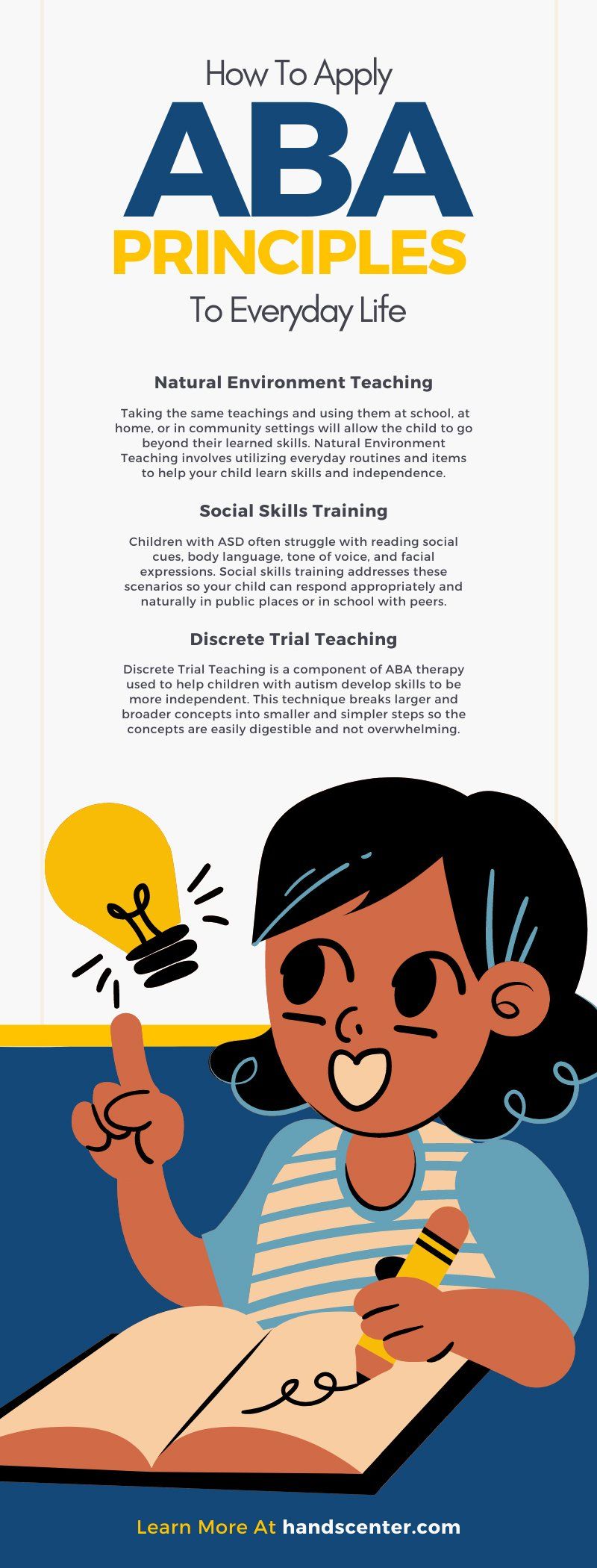How To Apply ABA Principles to Everyday Life
When your child attends their ABA therapy sessions, they learn social, behavioral, and emotional skills through one-on-one sessions that can be applied to everyday life. ABA centers will encourage parents, guardians, and teachers to use these same teachings in their day-to-day routines to help the child retain the information. ABA doesn’t have to be intense and strict. The principles of ABA can be applied through activities, language, and games to help shape their skills. Instead of sitting your child down through intense therapy, here are more simple and enjoyable ways to apply ABA principles to everyday life.
What Is ABA?
ABA stands for Applied Behavior Analysis, and behavioral technicians worldwide use this practice and techniques to help improve an individual’s way of life while promoting the capability to be independent. ABA helps us understand why a behavior occurs, why particular behaviors are learned, what triggers these behaviors, and how we can shape and teach new behavior responses.
If you have a child with autism spectrum disorder, you know that specific environments and scenarios can influence particular behaviors. Teaching your child how to cope with these emotions and master new skills appropriately may take time. But they need to learn these skills to help them succeed in school and other social settings or situations.
Why Do We Use ABA?
ABA therapy uses techniques that help teach children with autism how to respond to different scenarios and minimize inappropriate behaviors. By working with an ABA therapist, you will:
- Learn new coping skills and how to prevent inappropriate behaviors
- Set goals and outcomes
- Determine which behaviors need progress
- Evaluate your child’s behavior before, during, and after sessions
ABA has been scientifically proven to be influential in shaping and modifying behaviors and social skills to help improve the quality of life of children with ASD and their friends and family. The concepts used for ABA therapy also promote individuality and independence through approaches that best suit their areas of need and strengths.
How Can We Relate ABA to Everyday Life?
We use ABA approaches every day! You may not realize it, but you’ve experienced some principles that ABA reinforces in common social settings. You can use ABA in school, work, or community settings. You can use the following techniques in any social environment that may be appropriate.
Natural Environment Teaching
Learning and digesting new skills in a more serious setting like a therapist’s office may seem ideal. But using and learning these skills in one’s familiar environment may be a better option for the child. Taking the same teachings and using them at school, at home, or in community settings will allow the child to go beyond their learned skills. Natural Environment Teaching involves utilizing everyday routines and items to help your child learn skills and independence.
Ways you can use this technique in everyday situations include:
- Playing with others
- Improving communication skills
- Learning how to share with others
- Having a daily routine
- Identifying animals, colors, shapes, and everyday items
Social Skills Training
Children with ASD often struggle with reading social cues, body language, tone of voice, and facial expressions. Sometimes, these struggles may involve having trouble responding to greetings, detecting sarcasm or exaggerations, and holding long conversations. When interacting with individuals with ASD, it’s always best not to use creative language.
However, social skills training addresses these scenarios so your child can respond appropriately and naturally in public places or in school with peers.
You can apply this technique in everyday situations by:
- Practicing coping skills
- Establishing personal boundaries
- Understanding nonverbal or facial communication
- Making eye contact when talking or listening to someone
- Playing with their peers or siblings
- Learning how to take turns
Tip: It’s essential to allow your child to take their time rather than forcing them to overcome social situations. If your child is triggered or feeling uncomfortable, comfort them and try a different method. It’s important to allow them to adjust to new scenarios or people.
Discrete Trial Teaching
Discrete Trial Teaching is a component of ABA therapy used to help children with autism develop skills to be more independent. This technique breaks larger and broader concepts into smaller and simpler steps so the concepts are easily digestible and not overwhelming.
The key to Discrete Trial Teaching is understanding which skills your child needs help with the most and which skills have many steps to understand. Something that may seem simple to you might be difficult or too complex for your child. To simplify these complex skills, DTT is used to simplify every step involved. For example, teaching a child every color in the rainbow is broken down to each individual color until each color is digested and mastered.
You can apply Discrete Trial Teaching in everyday situations by:
- Teaching your child how to make eye contact
- Teaching your child different writing skills
- Teaching your child creative skills
- Teaching your child how to respond in social situations
- Teaching your child how to follow instructions
- Teaching your child how to use skills like dressing themselves, bathing, brushing teeth, etc.
What Else Can ABA Help With?
Believe it or not, ABA therapy and its techniques can be applied to every aspect of life and will help carry your child throughout their adult life as well. In the workplace, ABA can be used to help improve productivity and communication between staff and reduce work-related incidents. ABA can also be used in social settings with friends. Perhaps your friends are making inappropriate jokes or displaying inappropriate behavior; instead of laughing and entertaining them, you can stop them by not responding or laughing at their behavior. Using this technique will most likely reduce their behavior, and they will change their ways.
The possibilities and scenarios are endless, and there are numerous ways you can apply ABA principles to everyday life. HANDS Center for Autism offers ABA therapy services for individuals with autism who need an extra push to help digest social cues and learn appropriate social behaviors. ABA therapy will also teach them coping skills to help them be successful in any environment or scenario. These concepts are used in all aspects of our daily lives, and we can all learn from ABA.







